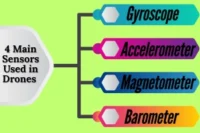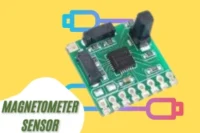Know These Drone Sensors for Better Flight Results
Published: 30 Jul 2025
Drones use more than just cameras to fly right. They rely on sensors like GPS, gyroscopes, accelerometers, magnetometers, barometers, and obstacle detectors. That’s a lot going on inside such a small machine. But what are the sensors used in drones, and why are they so important? In this guide, we’ll look at the most common sensors found in today’s drones and how each one plays a big role in making every flight smooth and safe.
Why Sensors Matter in Drone Flying
Sensors are what make drones smart. They help the drone stay balanced in the air and fly smoothly, even when the weather isn’t perfect. Without sensors, a drone wouldn’t know if it’s tilting, flying too high, or heading in the wrong direction. Sensors like GPS, gyroscopes, and barometers work together to help the drone avoid crashing into trees or buildings. They also help the drone know its exact location, height, and direction. For example, if a drone is flying in windy weather, sensors help it adjust in real-time to stay steady and avoid drifting away. That’s why sensors are a must-have in every drone.
1. GPS Sensor
The GPS sensor is like the brain’s map system for a drone. It tells the drone exactly where it is and where it needs to go. This sensor is one of the most important parts of modern drone flying.
Tracks Position : The GPS sensor helps the drone know its exact location on Earth. It uses satellite signals to figure out where it is—even when flying high or far away.
Return to Home : If the drone loses connection or battery runs low, GPS helps it fly back to where it took off. This is called the “Return to Home” feature, and it can save your drone from getting lost.
Follow Set Paths : Some drones can follow a path you draw on a map. GPS makes this possible by guiding the drone to each point accurately.
2. Gyroscope
The gyroscope is what keeps your drone steady, even when it tilts or turns in the air. It plays a key role in helping the drone stay balanced during flight, especially when it changes direction or faces wind.
Detects Tilting : The gyroscope senses when the drone leans to one side or begins to tilt. It quickly sends this data to the drone’s control system so it can adjust and stay level.
Maintains Stability : Whether the drone is turning, climbing, or descending, the gyroscope helps it stay stable. It stops the drone from wobbling or flipping unexpectedly.
Supports Smooth Flying : For video or photo capture, smooth flight is a must. The gyroscope ensures the drone doesn’t shake, helping you capture clearer, steadier footage.
3. Accelerometer
The accelerometer works like a motion detector inside the drone. It senses how fast the drone is moving, whether it’s tilting, and any quick changes in direction. This helps the drone stay steady and respond smoothly while flying.
Tracks Movement : The accelerometer measures how fast the drone is going and in which direction. It constantly checks for any sudden shifts in speed or angle.
Detects Tilting : Just like the gyroscope, it senses when the drone tilts—but with a focus on forward, backward, or sideways motion. This helps the drone adjust instantly to stay balanced.
Smooth Flight Support : When the drone speeds up, slows down, or turns, the accelerometer works with other sensors to keep the motion smooth. This is key for flying in a straight and stable path.
4. Magnetometer
The magnetometer is like a compass built into your drone. It helps the drone understand which way it’s facing so it can stay pointed in the right direction during flight.
Acts Like a Compass : The magnetometer detects the Earth’s magnetic field, just like a traditional compass. It helps the drone figure out which way is north, south, east, or west.
Maintains Orientation : Knowing direction is key when flying. The magnetometer works with other sensors to make sure the drone doesn’t spin or turn the wrong way during flight.
Supports GPS Navigation : When following a map or a set path, the drone needs to face the right way. The magnetometer helps guide the drone along that path accurately.
Real-Life Use : If you are filming a moving car or tracking a subject, the magnetometer keeps the drone and its camera pointed exactly where you want—without sudden shifts.
5. Barometer
The barometer helps the drone understand how high it is above the ground. It does this by measuring air pressure, which changes with altitude. This sensor is important for stable flying and safe landings.
Measures Air Pressure : The barometer reads the air pressure around the drone. Since air pressure drops as you go higher, the drone can use this data to calculate its exact height.
Maintains Stable Altitude : During flight, the drone needs to hold a steady height—especially when hovering. The barometer makes small adjustments to keep the drone from drifting up or down.
Improves Auto-Landing :When landing, the barometer helps the drone lower itself smoothly and safely. It knows how close the drone is to the ground and adjusts its speed.
6. Ultrasonic Sensor
The ultrasonic sensor helps the drone see how far it is from the ground. It sends sound waves down and measures how long they take to bounce back. This helps the drone fly safely close to the ground.
Senses Ground Distance : The ultrasonic sensor sends sound waves toward the ground. When they bounce back, the drone calculates how far it is from the surface.
Supports Safe Takeoff : During takeoff, this sensor helps the drone rise smoothly. It checks that there’s enough space below and keeps the drone from lifting off too fast.
Controls Soft Landing : When landing, the drone uses the ultrasonic sensor to slow down near the ground. This avoids hard drops and makes landings smooth and safe.
Real-Life Use : Imagine landing your drone on a rooftop or patio. The ultrasonic sensor checks the distance and adjusts descent speed so your drone doesn’t hit the surface too hard.
7. Infrared Sensor
The infrared sensor helps drones spot objects nearby. It uses invisible light or heat detection to sense when something is close. This is especially useful when flying at low speeds or in tight spaces.
Detects Nearby Objects : The sensor sends out infrared light or reads heat from surfaces. If something is close, the signal changes and the drone knows to slow down or stop.
Protects During Low-Speed Flights : When flying slowly indoors or near people, the infrared sensor watches for walls, furniture, or even hands. It helps prevent bumps and damage.
Improves Close-Range Safety : These sensors are great when GPS or vision sensors don’t work well like in dark rooms or small areas. They give the drone extra eyes for short distances.
8. Optical Flow Sensor
The optical flow sensor acts like a pair of eyes for the drone. It looks down at the ground, takes quick images, and tracks how things move beneath the drone. This helps the drone stay steady, even when GPS signals are weak.
Watch the Ground : The sensor captures tiny changes in the ground below by taking fast, repeated pictures. It compares these images to understand how the drone is moving.
Supports GPS-Free Hovering : In places where GPS doesn’t work like indoors or under trees—this sensor helps the drone stay in one spot by relying on visual cues from the ground.
Improves Indoor Flying : Flying inside can be tricky, but optical flow sensors help the drone hold position without drifting. This is great for smooth video shots or practicing control.
Real-Life Use : Imagine flying your drone inside a hall. Without GPS, it might drift. But with an optical flow sensor, it watches the floor and hovers steadily in place.
9. LiDAR Sensor
The LiDAR sensor takes drone vision to the next level. It uses laser beams to scan the surroundings and build a 3D map. This sensor is powerful and highly accurate, making it perfect for advanced tasks like mapping and inspections.
Scans with Laser Light : LiDAR sends out rapid laser pulses and measures how long they take to bounce back. This helps the drone understand distances and shapes in great detail.
Creates 3D Maps : By collecting thousands of data points, LiDAR builds a 3D model of the area. This is helpful in construction, farming, and surveying work.
Supports Precision Flying : In narrow or complex spaces, LiDAR helps the drone avoid obstacles with extreme accuracy. It’s more precise than regular obstacle sensors.
Final Thoughts
Drone sensors may be small, but they do big work. From GPS and gyroscopes to LiDAR and infrared, each sensor has a special job that helps the drone fly smarter, safer, and smoother. These sensors track direction, height, speed, and even nearby obstacles.
If you are just starting out, focus on learning the basics—like GPS, gyroscope, and accelerometer. These are must-haves for any beginner drone.
Before you buy a drone, always check the list of sensors it includes. Knowing what each one does can help you choose the right drone for your needs—and fly with confidence.





